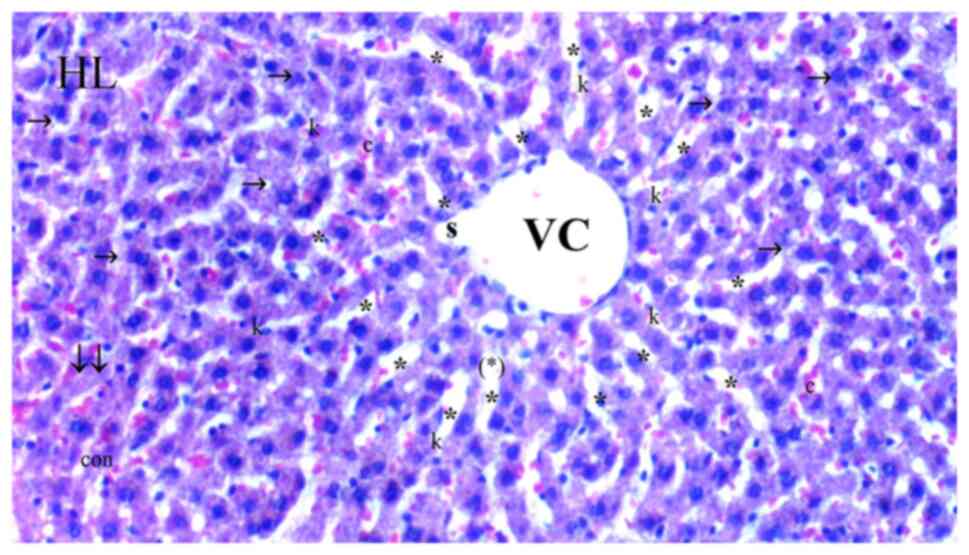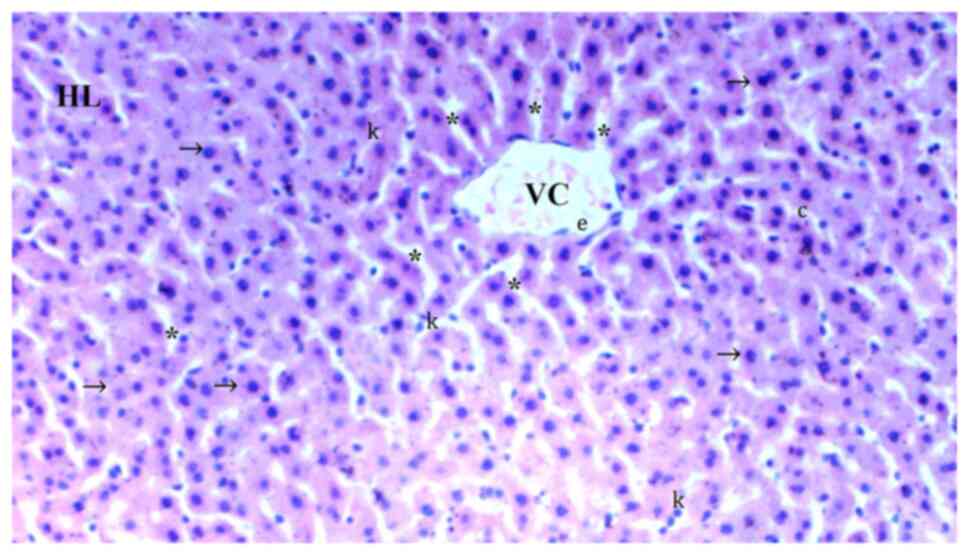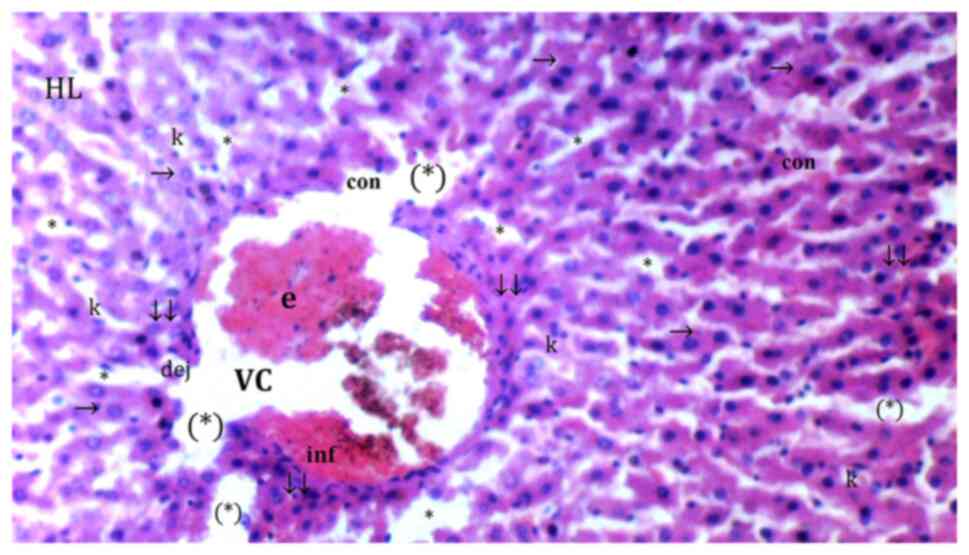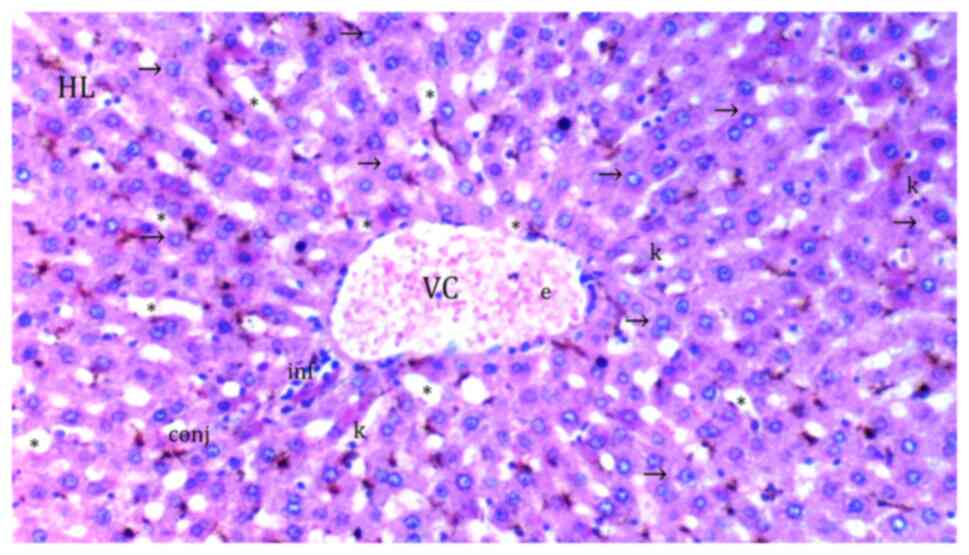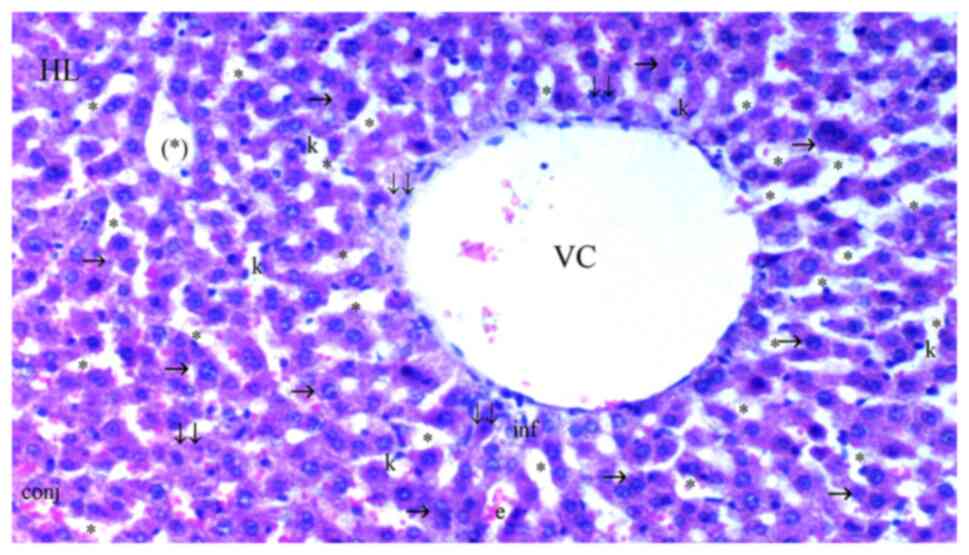|
1
|
Peralta C, Jiménez-Castro MB and
Gracia-Sancho J: Hepatic ischemia and reperfusion injury: Effects
on the liver sinusoidal milieu. J Hepatol. 59:1094–1106.
2013.PubMed/NCBI View Article : Google Scholar
|
|
2
|
Bhogal RH, Curbishley SM, Weston CJ, Adams
DH and Afford SC: Reactive oxygen species mediate human hepatocyte
injury during hypoxia/reoxygenation. Liver Transpl. 16:1303–1313.
2010.PubMed/NCBI View
Article : Google Scholar
|
|
3
|
Bonatsos V, Kappas I, Birbas K,
Vlachodimitropoulos D, Toutouzas K, Karampela E, Syrmos N, Bonatsos
G and Papalois AE: Effects of U-74389G (21-lazaroid) and ascorbic
acid on liver recovery after acute ischemia and reperfusion in
rats. In Vivo. 29:585–594. 2015.PubMed/NCBI
|
|
4
|
Liu A, Huang L, Fan H, Fang H, Yang Y, Liu
S, Hu J, Hu Q, Dirsch O and Dahmen U: Baicalein pretreatment
protects against liver ischemia/reperfusion injury via inhibition
of NF-κB pathway in mice. Int Immunopharmacol. 24:72–79.
2015.PubMed/NCBI View Article : Google Scholar
|
|
5
|
Ramalho LN, Pasta ÂA, Terra VA, Augusto M,
Sanches SC, Souza-Neto FP, Cecchini R, Gulin F and Ramalho FS:
Rosmarinic acid attenuates hepatic ischemia and reperfusion injury
in rats. Food and Chem Toxicol. 74:270–278. 2014.PubMed/NCBI View Article : Google Scholar
|
|
6
|
Córdoba-Jover B, Arce-Cerezo A, Ribera J,
Pauta M, Oró D, Casals G, Fernández-Varo G, Casals E, Puntes V,
Jiménez W and Morales-Ruiz M: Cerium oxide nanoparticles improve
liver regeneration after acetaminophen-induced liver injury and
partial hepatectomy in rats. J Nanobiotechnology.
17(112)2019.PubMed/NCBI View Article : Google Scholar
|
|
7
|
Colon J, Herrera L, Smith J, Patil S,
Komanski C, Kupelian P, Seal S, Jenkins DW and Baker CH: Protection
from radiation-induced pneumonitis using cerium oxide
nanoparticles. Nanomedicine. 5:225–231. 2009.PubMed/NCBI View Article : Google Scholar
|
|
8
|
Manne NDPK, Arvapalli R, Graffeo VA,
Bandarupalli VVK, Shokuhfar T, Patel S, Rice KM, Ginjupalli GK and
Blough ER: Prophylactic treatment with cerium oxide nanoparticles
attenuate hepatic ischemia reperfusion injury in sprague dawley
rats. Cell Physiol Biochem. 42:1837–1846. 2017.PubMed/NCBI View Article : Google Scholar
|
|
9
|
Estevez AY, Pritchard S, Harper K, Aston
JW, Lynch A, Lucky JJ, Ludington JS, Chatani P, Mosenthal WP,
Leiter JC, et al: Neuroprotective mechanisms of cerium oxide
nanoparticles in a mouse hippocampal brain slice model of ischemia.
Free Radic Biol Med. 51:1155–1163. 2011.PubMed/NCBI View Article : Google Scholar
|
|
10
|
Giri S, Karakoti A, Graham RP, Maguire JL,
Reilly CM, Seal S, Rattan R and Shridhar V: Nanoceria: A rare-earth
nanoparticle as a novel anti-angiogenic therapeutic agent in
ovarian cancer. PLoS One. 8(e54578)2013.PubMed/NCBI View Article : Google Scholar
|
|
11
|
Niu J, Azfer A, Rogers LM, Wang X and
Kolattukudy PE: Cardioprotective effects of cerium oxide
nanoparticles in a transgenic murine model of cardiomyopathy.
Cardiovasc Res. 73:549–559. 2007.PubMed/NCBI View Article : Google Scholar
|
|
12
|
Manne ND, Arvapalli R, Nepal N, Shokuhfar
T, Rice KM, Asano S and Blough ER: Cerium oxide nanoparticles
attenuate acute kidney injury induced by intra-abdominal infection
in Sprague-Dawley rats. J Nanobiotechnology. 13(75)2015.PubMed/NCBI View Article : Google Scholar
|
|
13
|
Rocca A, Moscato S, Ronca F, Nitti S,
Mattoli V, Giorgi M and Ciofani G: Pilot in vivo investigation of
cerium oxide nanoparticles as a novel anti-obesity pharmaceutical
formulation. Nanomedicine. 11:1725–1734. 2015.PubMed/NCBI View Article : Google Scholar
|
|
14
|
Tatar T, Polat Y, Çomu FM, Kartal H,
Arslan M and Küçük A: Effect of cerium oxide on erythrocyte
deformability in rat lower extremity ischemia reperfusion injury.
Bratisl Lek Listy. 119:441–443. 2018.PubMed/NCBI View Article : Google Scholar
|
|
15
|
Gubernatorova EO, Liu X, Othman A, Muraoka
WT, Koroleva EP, Andreescu S and Tumanov AV: Europium-Doped cerium
oxide nanoparticles limit reactive oxygen species formation and
ameliorate intestinal ischemia-reperfusion injury. Adv Healthc
Mater 6: May 8, 2017 (Epub ahead of print).
|
|
16
|
Tuncay A, Sivgin V, Ozdemirkan A, Sezen
SC, Boyunaga H, Kucuk A, Gunes I and Arslan M: The effect of cerium
oxide on lung tissue in lower extremity ischemia reperfusion injury
in sevoflurane administered rats. Int J Nanomedicine. 15:7481–7489.
2020.PubMed/NCBI View Article : Google Scholar
|
|
17
|
Perouansky M, Pearce RA and Hemmings HC:
Inhaled Anesthetics: Mechanism of Action. In: Miller Anesthesia
Eight Edition. Miller RD (ed.). Elsevier Saunders Inc., Philadephia
PA, pp614-635, 2015.
|
|
18
|
Bedirli N, Ofluoglu E, Kerem M, Utebey G,
Alper M, Yilmazer D, Bedirli A, Ozlu O and Pasaoglu H: Hepatic
energy metabolism and the differential protective effects of
sevoflurane and isoflurane anesthesia in a rat hepatic
ischemia-reperfusion injury model. Anesth Analg. 106:830–837, table
of contents. 2008.PubMed/NCBI View Article : Google Scholar
|
|
19
|
Nielsen VG, Tan S, Kirk KA, Baird MS,
McCammon AT, Samuelson PN and Parks DA: Halothane and xanthine
oxidase increase hepatocellular enzyme release and circulating
lactate after ischemia-reperfusion in rabbits. Anesthesiology.
87:908–917. 1997.PubMed/NCBI View Article : Google Scholar
|
|
20
|
Zhong M, Che L, Du M, Liu K and Wang D:
Desflurane protects against liver ischemia/reperfusion injury via
regulating miR-135b-5p. J Chin Med Assoc. 84:38–45. 2021.PubMed/NCBI View Article : Google Scholar
|
|
21
|
Sloan MH, Conard PF, Karsunky PK and Gross
JB: . Sevoflurane versus isoflurane: Induction and recovery
characteristics with single-breath inhaled inductions of
anesthesia. Anesth Analg. 82:528–532. 1996.PubMed/NCBI View Article : Google Scholar
|
|
22
|
TerRiet MF, DeSouza GJ, Jacobs JS, Young
D, Lewis MC, Herrington C and Gold MI: Which is most pungent:
Isoflurane, sevoflurane or desflurane? Br J Anaest. 85:305–307.
2000.PubMed/NCBI View Article : Google Scholar
|
|
23
|
Yang P, Du Y, Zeng H, Xing H, Tian C and
Zou X: Comparison of inflammatory markers between the sevoflurane
and isoflurane anesthesia in a rat model of liver
ischemia/reperfusion injury. Transplant Proc. 51:2017–2075.
2019.PubMed/NCBI View Article : Google Scholar
|
|
24
|
Hayvan Deneyleri Merkezi Etik Kurulu.
Mevzuat. Available from: https://hadmek.tarimorman.gov.tr/Sayfa/Detay/644.
Accessed November 22, 2022.
|
|
25
|
Abdel-Wahhab MA, Nada SA and Arbid MS:
Ochratoxicosis: Prevention of developmental toxicity by
L-methionine in rats. J Appl Toxicol. 19:7–12. 1999.PubMed/NCBI View Article : Google Scholar
|
|
26
|
Hodges DM, DeLong JM, Forney CF and Prange
RK: Improving the thiobarbituric acid-reactive-substances assay for
estimating lipid peroxidation in plant tissues containing
anthocyanin and other interfering compounds. Planta. 207:604–611.
1999.
|
|
27
|
Aebi H: Catalase. In: Methods of Enzymatic
Analysis. Bergmeyer H (ed). Academic Press, New York, London,
pp673-677, 1974.
|
|
28
|
Habig WH, Pabst MJ and Jakoby WB:
Glutathione S-transferases. The first enzymatic step in mercapturic
acid formation. J Biol Chem. 249:7130–7139. 1974.PubMed/NCBI
|
|
29
|
Li J, Wang F, Xia Y, Dai W, Chen K, Li S,
Liu T, Zheng Y, Wang J, Lu W, et al: Astaxanthin pretreatment
attenuates hepatic ischemia reperfusion-induced apoptosis and
autophagy via the ROS/MAPK pathway in mice. Mar Drugs.
13:3368–3387. 2015.PubMed/NCBI View Article : Google Scholar
|
|
30
|
Ibrahim HG, Attia N, Hashem FEZA and El
Heneidy MAR: Cerium oxide nanoparticles: In pursuit of liver
protection against doxorubicin-induced injury in rats. Biomed
Pharmacother. 103:773–781. 2018.PubMed/NCBI View Article : Google Scholar
|
|
31
|
Kobyliak N, Abenavoli L, Falalyeyeva T,
Virchenko O, Natalia B, Beregova T, Bodnar P and Spivak M:
Prevention of NAFLD development in rats with obesity via the
improvement of pro/antioxidant state by cerium dioxide
nanoparticles. Clujul Med. 89:229–235. 2016.PubMed/NCBI View Article : Google Scholar
|
|
32
|
Oró D, Yudina T, Fernández-Varo G, Casals
E, Reichenbach V, Casals G, González de la Presa B, Sandalinas S,
Carvajal S, Puntes V and Jiménez W: Cerium oxide nanoparticles
reduce steatosis, portal hypertension and display anti-inflammatory
properties in rats with liver fibrosis. J Hepatol. 64:691–698.
2016.PubMed/NCBI View Article : Google Scholar
|
|
33
|
Granger DN and Korthuis RJ: Physiologic
mechanisms of postischemic tissue injury. Annu Rev Physiol.
57:311–332. 1995.PubMed/NCBI View Article : Google Scholar
|
|
34
|
Matés JM, Pérez-Gómez C and Núñez de
Castro I: Antioxidant enzymes and human diseases. Clin Biochem.
32:595–603. 1999.PubMed/NCBI View Article : Google Scholar
|
|
35
|
Hochhauser E, Lahat E, Sultan M, Pappo O,
Waldman M, Sarne Y, Shainberg A, Gutman M, Safran M and Ben Ari Z:
Ultra low dose delta 9-tetrahydrocannabinol protects mouse liver
from ischemia reperfusion injury. Cell Physiol Biochem.
36:1971–1981. 2015.PubMed/NCBI View Article : Google Scholar
|
|
36
|
Yokel RA, Hussain S, Garantziotis S,
Demokritou P, Castranova V and Cassee FR: The yin: An adverse
health perspective of nanoceria: Uptake, distribution,
accumulation, and mechanisms of its toxicity. Environ Sci Nano.
1:406–428. 2014.PubMed/NCBI View Article : Google Scholar
|
|
37
|
Manne ND, Arvapalli R, Nepal N, Thulluri
S, Selvaraj V, Shokuhfar T, He K, Rice KM, Asano S, Maheshwari M
and Blough ER: Therapeutic potential of cerium oxide nanoparticles
for the treatment of peritonitis induced by polymicrobial insult in
Sprague-Dawley rats. Crit Care Med. 43:e477–e489. 2015.PubMed/NCBI View Article : Google Scholar
|
|
38
|
Graham UM, Tseng MT, Jasinski JB, Yokel
RA, Unrine JM, Davis BH, Dozier AK, Hardas SS, Sultana R, Grulke EA
and Butterfield DA: In vivo processing of ceria nanoparticles
inside liver: Impact on free-radical scavenging activity and
oxidative stress. Chempluschem. 79:1083–1088. 2014.PubMed/NCBI View Article : Google Scholar
|
|
39
|
Figueira ERR and Filho JAR: Is there a
place for sevoflurane to prevent liver ischemia-reperfusion injury
during liver transplantation? Edorium J Anesth. 1:1–5. 2015.
|
|
40
|
Kan C, Ungelenk L, Lupp A, Dirsch O and
Dahmen U: Ischemia-reperfusion injury in aged livers-the energy
metabolism, inflammatory response, and autophagy. Transplantation.
102:368–377. 2018.PubMed/NCBI View Article : Google Scholar
|
|
41
|
Jeong JS, Kim D, Kim KY, Ryu S, Han S,
Shin BS, Kim GS, Gwak MS and Ko JS: Ischemic preconditioning
produces comparable protection against hepatic ischemia/reperfusion
injury under isoflurane and sevoflurane anesthesia in rats.
Transplant Proc. 49:2188–2193. 2017.PubMed/NCBI View Article : Google Scholar
|
|
42
|
Jaiswal AK: Nrf2 signaling in coordinated
activation of antioxidant gene expression. Free Radic Biol Med.
36:1199–1207. 2004.PubMed/NCBI View Article : Google Scholar
|
|
43
|
Lee HT, Ota-Setlik A, Fu Y, Nasr SH and
Emala CW: Differential protective effects of volatile anesthetics
against renal ischemia-reperfusion injury in vivo. Anesthesiology.
101:1313–1324. 2004.PubMed/NCBI View Article : Google Scholar
|
|
44
|
Wu Y, Gu C and Huang X: Sevoflurane
protects against hepatic ischemia/reperfusion injury by modulating
microRNA-200c regulation in mice. Biomed Pharmacother.
84:1126–1136. 2016.PubMed/NCBI View Article : Google Scholar
|
|
45
|
Ma H, Yang B, Yu L, Gao Y, Ye X, Liu Y, Li
Z, Li H and Li E: Sevoflurane protects the liver from
ischemia-reperfusion injury by regulating Nrf2/HO-1 pathway. Eur J
Pharmacol. 898(173932)2021.PubMed/NCBI View Article : Google Scholar
|
|
46
|
Bashandy PhD MM, Saeed HE, Ahmed WMS,
Ibrahim MA and Shehata O: Cerium oxide nanoparticles attenuate the
renal injury induced by cadmium chloride via improvement of the NBN
and Nrf2 gene expressions in rats. Toxicol Res (Camb). 11:339–347.
2022.PubMed/NCBI View Article : Google Scholar
|
|
47
|
McGill MR: The past and present of serum
aminotransferases and the future of liver injury biomarkers. EXCLI
J. 15:817–828. 2016.PubMed/NCBI View Article : Google Scholar
|















